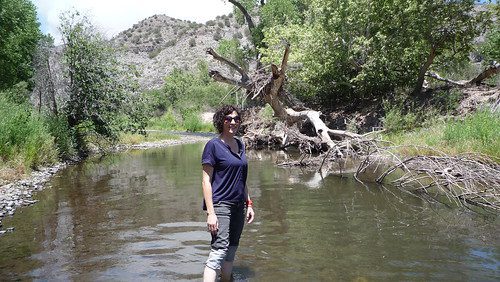
My view of the Gila is skewed by the season.
It’s almost the pinnacle of dry season, and the last couple of years have been at drought-level.
The rains should come in July, but meanwhile, I drive around seeing as many kinds of dry as their are snow.
As I’ve been driving around seeing so much dry cracked parched earth, when I see water – any water – my body has a reaction long before I process desire into language. A muddy stock tank (disappointment), a trickle (scanning the landscape), a still puddle in a creek bottom near a source (crestfallen), a bright-sided narrow running stream (joy), a river like this one, hidden as it is behind a dense riparian screen (awe and a total need to get in it, shoes and jeans, to slide and splash along its fairly shallow course). The Gila River is another story of the West: it’s a long tributary of the Colorado; it’s one of the last free-flowing “wild” rivers in the Southwest and the arterial mainstream of the Gila. The river is of course another site of contest; a river – although not wolfishly furry – is the big symbol of use and identity as it snakes through the land in the West.
This recent article again describes the polarities and the issues and is worthy of a long social analysis.
Stemming from America’s first wilderness area, the Gila River flows through the mountains of southwestern New Mexico, across the high desert and through the heart of Arizona, providing water to farmers and communities along the way.
The last free-flowing river in New Mexico and one of the few in the Southwest to hold on to so many of its native fish communities, changes could be in store for the Gila.
New Mexico is finally on the verge of accessing billions of gallons of river water through a series of settlements that stretch back to the late 1960s. Along with access to the water comes millions of dollars in federal funding to help develop that water.
The question that state water managers and residents throughout southwestern New Mexico are grappling with is how to best accomplish that.
With much of New Mexico in the clutches of a persistent drought, few want to turn down the opportunity for a new source of water. However, diverting any water from the river will cost money, and no one wants to upset the balance of the river’s already fragile ecology.
Catron County Commission Chairman Hugh McKeen called the process frustrating and aggravating. He accused environmentalists of pushing an agenda that has resulted in overgrown forests and a crippled economy.
“In Arizona, there are dams on the Gila and the San Francisco. You see lakes,” he said. “We only have one little lake in Catron County, the biggest county in the state. Why are we so backward? Wherever you see dams and lakes, you see prosperity. You see people with a future.”
Others see the Gila as an iconic river. They argue that 14,000 acre-feet can be realized through smarter management and conservation rather than skimming water from the river during high flows, as allowed by the settlement.
This is not a simple matter of water for human use vs water as a symbol.